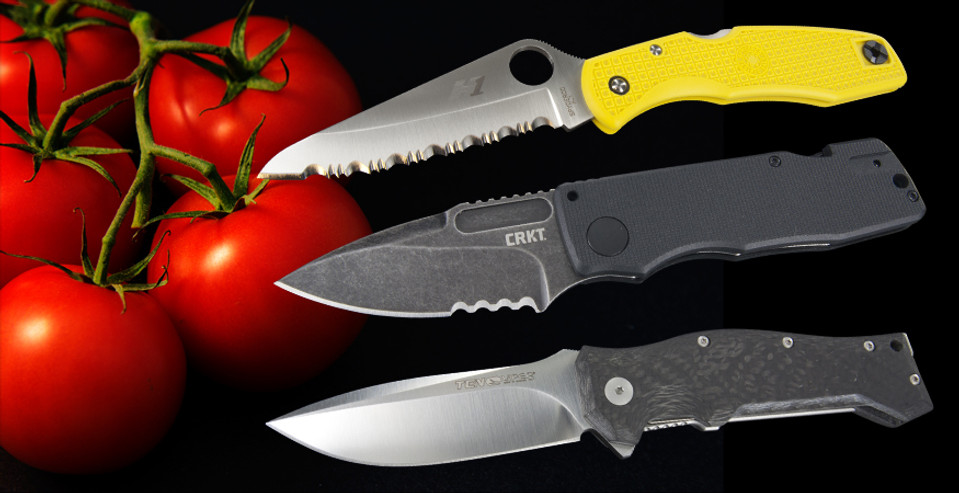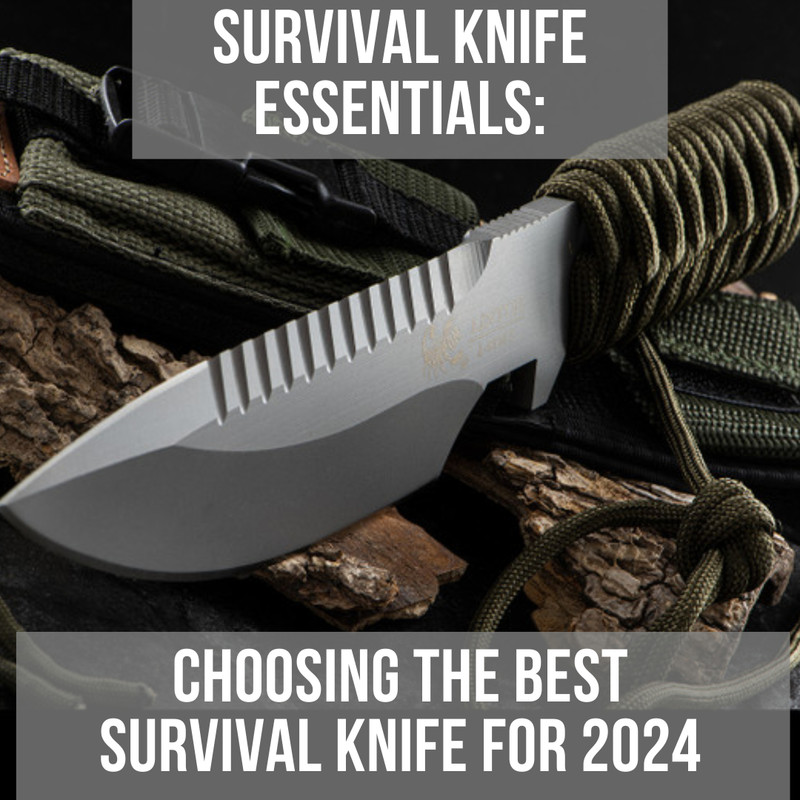How do you decide between plain, serrated and part serrated knife blades?
Posted by HH on 14th Aug 2015
You can’t even look at buying a pocket knife these days without a questions staring you in the face: Do I buy a plain edge knife? A serrated knife? Or even a part-serrated blade?
What makes this decision is made even more difficult is that most knife companies now release their new models with the option of plain, partially serrated and sometimes even fully serrated blades.
In this post we will attempt to unmask the differences between the three types of blade edge, then look at who needs what style edge.
Intro
In the not to recent past, there was only really one type of edge: the plain edge. It wasn’t until more recently that serrated edges began to grow in popularity. In order to fully understand the differences between the styles we first have to look at the types of cuts a knife can make. The first is a push cut. This is done when you push a knife through something (shaving or chopping fruit/veg). The second is the pull cut. These are cuts that require you to pull the knife across something in order to cut it (like rope/cord and bread). Now we will look in a little more detail at the differences:
Push cuts: The main cutting is done by ‘pushing’ the edge through the thing-to-be-cut. For example, when you shave, you push the edge of the knife through your beard. When peeling an apple, you push the edge under the skin of the apple. When chopping wood, you try to push the edge into and through the wood.
Slicing cuts: The cutting action is substantially done by dragging the edge across the thing-to-be-cut. When you slice meat or a tomato, you drag the edge across the tomato as you cut through it. Slicing and sawing are examples of slicing cuts.
The differences
The main difference between plain edge blade and serrated knife comes down to how you use your blade. As we’ve just explained plain edges are better for push cuts and serrated edges are better for slicing cuts.
Why? Plain gives you better control and gives cleaner cuts. Serrated are better for tougher surfaces, also many people believe that the serrations mean the blade can still cut even when slightly less sharp, this is in part due to most standard serrations to be chisel ground (very thin and sharp).
The case of the tomato
The tomato proves this point nicely in theory. You should be able to just push a blade through a tomato, so a razor sharp ‘polished’ plain edge would work fine. However, imagine the tomato is soft, and unless your plain edge knife is very sharp, the tomato will simply squish when you start pushing. You can (and most people do) use a slicing motion with your serrated blade, and even if the blade is a little dull, the tomato will still cut. Using this sawing motion with a serrated knife (even a dull one), and your tomato will slice fine.
Tests like above are great. They do give a good idea of which edge works best for a given tasks. However the vast majority of these tests have a flaw. . . The problem is that when testing plain vs. serrated performance, most tests are comparing a plain ‘polished’ edge to a serrated edge. When you are therefore comparing a slicing test serrated edges will win every time. That is because the tests do not take into account methods of sharpening a plain edged knife that doesn’t give it a polished edge.
With the right sharpening stones (coarser stones) you can get the plain edge to perform much better in slicing tests. We’ve also seen and heard of people using files to sharpen their edges in order to create micro serrations for cutting rope etc etc. Most tests don’t take into account these slightly modified knives. That being said though for the average joe who just wants a knife that will work without having to sharpen and regrind then there is nothing wrong with using a standard serrated knife.
Now we will look at the pros and cons of each
Plain Edge
As we’ve just established push cuts equals plain edge. Generally, the more push cuts are used, the more necessary it is for the plain edge to have a ‘polished’ edge. A knife edge becomes more polished when you move to higher and higher grit stones. Generally, 1200-grit is considered polished; a 6000+ grit Japanese water stone would polish the edge further.
Pros: Having a pocket knife with a plain edge is better at performing push cuts. The single sharp edge will also allow for increased accuracy and cleaner cuts (won’t tear). A separate advantage is that the plain edges are significantly easier to sharpen and don’t require you to send it back to the factory for sharpening or require more specialist sharpening techniques and tools
Cons: One of its major downsides is its inability to saw and perform pull cuts (unless you want to spend time and effort trying to create micro serrations). By only having the one type of edge you are potentially limiting the number of uses your knife has. Sure for push cuts you have the best of blades, but what happens if you need for perform slicing cuts and haven’t got the ability to adjust the edge on your blade?
Recommended Uses: If you find yourself performing push cuts throughout the day, a plain edge will suit you well. Although it doesn’t perform well on wood or rope, it will excel at things like shaving and skinning animals. Most people will use these push cuts most often!
Fully Serrated Edge
In general the serrated edge will be superior when slicing through thick, tough and more fibrous materials. Serrated edges tend to “grab” or grip the surface of what you’re cutting easily. Because the high points on the serration meet the object first, there will be more pressure per area available at these high points (in basic English means there is more pressure on fewer points of contact). This will allow the serration to puncture and tear the object faster. Even dull serrations excel at slicing objects and this is often the reason people often prefer serrations and believe they stay sharper, longer.
Pros: The disadvantages of the plain edge are the advantages of the fully serrated knife edge. It does a better job with cutting tougher materials (due to the increased pressure we just mentioned). Serrations also tend to be thinner (usually chisel ground) than most plain edges, which allows them to cut better than plain edge knives.
Cons: Serrated blades, while better at cutting hard materials, are less precise then plain edges and can tear the object being sliced. Serrations are also significantly more difficult to sharpen. In most cases, if you to retain the original blade, you would need to send it back to the factory for sharpening or buy some specific sharpening materials for serrated edges.
Recommended Uses: Have a think about your everyday tasks. If you realise there’s a lot of hard cutting and sawing, a serrated edge is your best bet. Although it has some limitations, a fully serrated blade is useful in specific situations.
Partially Serrated Edge (Combo Edge)
Partially serrated blades are a topic people debate for hours, discussing whether they are good or not.
Let’s start with the positives: You get two for the price of one. Sure neither is a specific tool, but for an EDC knife are likely to need a range of tasks doing, having options is always beneficial. Some people ‘polish’ the front end of the knife so that it’s still very effective for the push cuts, but then you still have the serrations as an effective slicing tool. Some call this compromise, others say it’s diluting the benefits of each individually.
On the negative side. Other people feel that partially-serrated blades are often serrated at the “wrong” place. For example, for camp use, some of you might want the belly serrated for cutting my certain foods, and the part near the handle razor-polished for whittling and control-type usage. However, 99% of partially-serrated blades are ground exactly the opposite: the ripping inaccurate serrations are at the control part of the blade, and the plain part is out at the slicing part. This is not to say that serrated edges at the back aren’t good as there are loads of tasks which to require the format of the knife to be that way.
With specific regards to the split of plain Vs serrations of a single blade. We’ve found that typically, the 50%-60% of the blade nearest the tip is plain, while the back 40%-50% is serrated. However, keep in mind that on a 3.25″ (just over 8cm) blade, there’s maybe 1.25″ (just over 3cm) of serrations. The detractors of this format feel that the length of serrations is too short to be really useful, and the length of the plain edge is being sacrificed for no good gain.
Now to the actual pros and cons:
Pros: A partially serrated edge is a mixture of both edge types and has overtaken the fully serrated edge in popularity. The combo edge is more popular because it allows you to use part of the knife for push cuts and the other part for rigorous cutting. Having both types of edge also adds to the versatility of the knife, making it more useful in a larger number of situations.
Cons: The combo edge has some of the same disadvantages of a serrated edge, such as sharpening difficulties. However, other aspects, like its accuracy are increased but not to the level of a purely plain blade. Another thing to consider is the placement of the serrations on the blade because they aren’t always useful for certain tasks.
Recommended Uses: If you’re looking for the best of both worlds, a partially serrated edge is the way to go. It combats some of the negatives of serrated edges but allows you to keep the sawing ability on your knife without having to re-sharpen the edge to get those micro serrations we talked about.
Summary
Personal preference and tasks you need the knife for are the two real considerations when looking at edge type. Plain for push cuts, serrated for slice cuts and in between if you’re likely to encounter a range of push and slicing tasks. If you are an experienced knife user and well practiced at sharpening techniques, you may favour the plain edge as you will be able to create the micro serrations if needed. However, that isn’t applicable to everyone.







